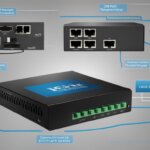Table of Contents
WiFi has become an essential part of our daily lives, providing wireless networking and internet connectivity. But have you ever wondered how it all works?
802.11 is the set of standards for wireless local area networks (WLANs), commonly known as WiFi. It defines the protocols and technologies used to establish and maintain wireless communication between devices.
In this section, we will explore the basics of WiFi and delve into the concept of 802.11. We will discuss its crucial role in wireless networking and its significance in providing internet connectivity to billions of devices worldwide.
Key Takeaways
- 802.11 is the set of standards for wireless local area networks (WLANs).
- It defines the protocols and technologies used to establish and maintain wireless communication between devices.
- WiFi is crucial for wireless networking and internet connectivity.
- Billions of devices worldwide rely on WiFi for communication and data transfer.
- Understanding 802.11 is vital in harnessing the power of WiFi and staying connected in today’s digitally driven world.
The Evolution of 802.11: From 802.11a to 802.11ac
The 802.11 standard has undergone significant evolution since its inception. Let’s explore the different iterations:
| Version | Release date | Max speed | Frequency band |
|---|---|---|---|
| 802.11a | 1999 | 54 Mbps | 5 GHz |
| 802.11b | 1999 | 11 Mbps | 2.4 GHz |
| 802.11g | 2003 | 54 Mbps | 2.4 GHz |
| 802.11n | 2009 | 600 Mbps | 2.4/5 GHz |
| 802.11ac | 2014 | 6.77 Gbps | 5 GHz |
As can be seen in the table above, each version of the 802.11 standard has introduced significant advancements. The introduction of 802.11a in 1999 marked the first major improvement over the initial version of 802.11, with a faster maximum speed and a different frequency band. 802.11b, released the same year, introduced 2.4 GHz support and is still used today for low-bandwidth applications.
802.11g, released in 2003, increased the maximum speed to 54 Mbps, and 802.11n, released in 2009, boasted up to 600 Mbps speeds with support for both 2.4 and 5 GHz frequencies. The latest iteration, 802.11ac, was released in 2014 and has a maximum speed of 6.77 Gbps, using only the 5 GHz frequency band.
The evolution of 802.11 has enabled faster download and upload speeds, improved range, and better overall performance, revolutionizing the way we use wireless internet connectivity today.
Understanding the Key Components of 802.11
In wireless networking, 802.11 is the most popular standard for establishing WiFi connections. It has revolutionised the way people connect to the internet and to other devices. 802.11 helps in the establishment of WiFi networks, and the key components that play a vital role in this process are access points, wireless routers, and wireless devices. Let’s understand each of these components in detail.
Access Points
An access point connects wireless devices to a wired network. It acts like a bridge that makes communication between wireless devices and a network possible. They receive and transmit wireless signals and act as a connection hub for all devices in the network. Access points can be standalone or can be integrated into wireless routers.
Wireless Routers
A wireless router is a networking device that allows multiple devices to connect wirelessly to the internet or a local network. In addition to performing the functions of an access point, it provides internet connectivity and may also act as a firewall or a network switch. Wireless routers are the most common way to establish a WiFi network in homes and small businesses.
| Wireless Routers | Access Points |
|---|---|
| Acts as a networking device | Connects wireless devices to wired networks |
| Provides internet connectivity | Acts as a bridge for communication between wireless devices and networks |
| Acts as a firewall or network switch | Receives and transmits wireless signals |
| Used in homes and small businesses | Can be standalone or integrated into wireless routers |
Wireless Devices
Wireless devices are electronic gadgets such as smartphones, laptops, tablets, and gaming consoles that are equipped with WiFi capabilities. They can connect to a wireless network to access the internet or communicate with other wireless devices in the network. The popularity of wireless devices has made WiFi a ubiquitous technology that is essential for staying connected in today’s world.
While the key components of 802.11 make establishing WiFi networks possible, it is important to note that wireless communications can also result in security issues. As a result, it is crucial to implement security protocols and encryption methods that protect wireless communications against unauthorized access. This can help ensure that data transmitted over the network remains confidential and secure.
Conclusion
In summary, this article has provided a comprehensive overview of 802.11, otherwise known as WiFi. We explored the basics of WiFi and discussed the significance of 802.11 in wireless networking and internet connectivity, which has become increasingly important in today’s digitally driven world. From the early days of 802.11a to the latest version of 802.11ac, we detailed the evolution of the standard and the strides made in terms of speed, range, and overall performance.
Furthermore, we delved into the key components of 802.11, emphasising the vital role of access points, wireless routers, and wireless devices. We highlighted the importance of security protocols and encryption methods in safeguarding wireless communications, which has become increasingly crucial in light of rising cybersecurity threats.
Overall, understanding 802.11 is paramount in harnessing the power of WiFi and staying connected in today’s digital landscape. We hope that this article has provided you with valuable insights into the fundamentals of WiFi and the role of 802.11 in wireless networking and internet connectivity.
FAQ
What is 802.11?
802.11 is a set of standards that governs wireless networking technologies, commonly referred to as WiFi. It enables devices to connect to the internet wirelessly, allowing for seamless communication and data transfer.
What are the basics of WiFi?
WiFi, short for wireless fidelity, is a technology that uses radio waves to provide wireless internet connectivity. It allows devices to connect to a local area network (LAN) and access the internet without the need for physical cables.
What is the evolution of 802.11?
The 802.11 standard has evolved over the years to improve wireless networking performance. It started with 802.11a, followed by 802.11b, 802.11g, 802.11n, and the latest version is 802.11ac. Each iteration introduced advancements in terms of speed, range, and overall network efficiency.
What are the key components of 802.11?
The key components of 802.11 include access points, wireless routers, and wireless devices. Access points serve as hubs that enable wireless devices to connect to a network. Wireless routers manage the network, while wireless devices such as laptops, smartphones, and tablets use WiFi to access the internet.
Why is security important in 802.11 networks?
Security is crucial in 802.11 networks to protect sensitive information and prevent unauthorized access. Encryption methods and security protocols are employed to secure wireless communications, ensuring that data transmitted over WiFi is safe from interception and misuse.













